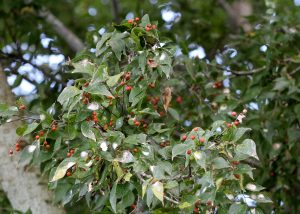Sugarberry or Hackberry, Celtis laevigata

Photo by Wendy VanDyk Evans, Bugwood.org

Photo by Mary Keim
Height: 60 to 80 feet
Spread: 30 to 50 feet
LANDSCAPE USE
Works well as a specimen or shade tree and is a good choice for parking lots and roadsides. Attractive to wildlife, including butterflies, songbirds, and especially yellow-bellied sapsucker woodpeckers.
FORM
A large, spreading tree with a rounded crown and stout, zigzag branches.
NATIVE RANGE
Floodplain forests and calcareous river swamps. Indiana and Virginia south ward, throughout Florida and west to Texas.
CHARACTERISTICS
Flowers: Yellowish green, small, and inconspicuous.
Leaves: Alternate, simple, 2-5 inches long, minutely toothed on the margins, light green during summer but turning yellow in the fall, somewhat wedge shaped in overall outline and tapering to a long, often curving point.
Fruit: Reddish orange to yellowish drupes that turn dark in the fall.
Bark: Gray; sometimes with warty outgrowths, mostly from injury by woodpeckers, but often nearly as smooth as that of American beech (Fagus grandifolia).
CULTURE
Soil: Does best in moist, rich situations, but adapts well to a variety of soils from acid to alkaline and is very drought tolerant.
Exposure-: Part shade to full sun.
Water: irrigate to keep soil moist, but not wet, until established. Will adapt to drier sites.
Hardiness Zones: 4 to I0.
Life Span: Moderately long-lived; probably not exceeding 150 years.
BEST FEATURES including WILDLIFE SUPPORT
A relatively fast-growing tree that is excellent for alkaline soils. Its attractive grayish, warty bark makes it an interesting, attractive, and easy to-grow shade tree. It does well in urban and suburban situations, and although deciduous, it maintains its charm and beauty during winter. Its appearance improves with age. Does very well on disturbed soils. This tree is a host for many butterlies and moths, which are in turn critical food for birds. If you see web worms, consider that they do not harm the tree and are good food for birds.
COMPANION PLANTS
Oaks (Quercus spp.), American Beech (Fagus grandifolia), Sweetgum (Liquidambar styraciflua), Blue Beech (Carpinus caroliniana), Gumbo Limbo (Bursera simaruba), Satinleaf (Chrysophyllum oliviforme), Pignut Hickory (Carya glabra), Winged Elm (Ulmus alata), Redbud (Cercis canadensis), American Hophornbeam (Ostrya virginiana), Beautyberry (Callicarpa americana), Cherokee Bean (Erythrina herbacea), Witch Hazel (Hamamelis virginiana), Yaupon (Ilex vomitoria), Needle Palm (Rhapidophyllum hystrix), Bluestem Palmetto (Sabal minor).
DISADVANTAGES
Hackberry has a shallow root system that may prevent other plants from growing beneath it.
CULTIVARS
‘All Seasons’ Hackberry is a selection of C. laevigata but is not used in Florida.
SIMILAR AND RELATED SPECIES
The Dwarf or Georgia hackberry (C. tenuifolia), which occurs naturally in Florida in rich, shaded woodlands of the northern peninsula and panhandle, is a small tree that resembles a miniature Hackberry.